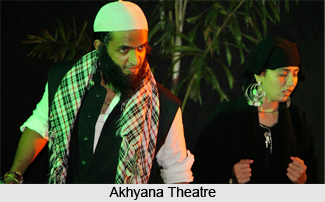 Akhyana was a folk musical theatre art form as well as medieval genre of Gujarati poetry, primarily prevalent in the western Indian state of Gujarat.
Akhyana was a folk musical theatre art form as well as medieval genre of Gujarati poetry, primarily prevalent in the western Indian state of Gujarat.
Etymology and Definition of Akhyana
The term "Akhyana" is a Sanskrit word, literally meaning "to tell or narrate". The 12th century polymath Hemchandra defined Akhyana in his work "Kavyanusashana", as a side story from religious texts narrated by a "Granthika" (professional story teller) to instruct audience, accompanied with singing and acting. This definition does not include the narration of other non-mythological stories like those of Narsinh Mehta. In general, Akhyana may be defined as the stories narrated by a story teller, for religious instructions to the audience accompanied by songs and acting. Dolarrai Mankad defined it as a form of poetry, with musical components and scope of acting.
History of Akhyana
Akhyana has been described as a form of poetry in the 12th century work of Hemchandra, "Kavyanusashana". The 15th century poet Bhalan wrote large number of Akhyanas, including the popular one "Nalakhyan" depicting the story of Nala-Damayanti. Nakar of 16th century was one of the few non-Brahmin authors. Bhoja Bhagat and Shamal Bhatt of 17th century wrote several Akhyanas. Veerji of the same period wrote "Balirajanu" Akhyana, based on the story of Mahabali. Thus, the Akhyana art form had reached its peak during the 16th and 17th centuries. One of the most popular exponents of the art during the time was Premanand Bhatt. He wrote "Okhaharan" based on the Aniruddha-Usha story. The trend continued to decline thereafter and became almost extinct by the 19th century. Later, some Gujarati poets of modern times like Balmukund Dave wrote Akhyana as genre of poetry, but the performance of Akhyana was never revived.
Stage Performance and Form of Akhyana
Akhyana is recited by the narrators or professional story tellers, who were called "Manabhatt" or "Gagaria-bhatt". They set poetry to musical tunes and did mono acting. They wore rings on their fingers that were used to sound the beats on overtuned copper pots. "Mana" or "Gagar" literally mean pot in Gujarati.
Akhyanas were recited by the Manabhatts who belonged to the Brahmin caste only. Thus, the Akhyana authored by the person of other castes were given to them for recitation. Nakar was one such non-Brahmin, belonging to the Bania caste, who was an author of medieval Gujarati literature.
The subjects taken in the enactment of Akhyana include religious episodes from mythological stories as well as epics like Ramayana and Mahabharata. Sometimes, non-mythological stories of religious devotees such as Narsinh Mehta were also enacted.
The Akhyana literary forms are divided into several stanzas, collectively called "Kadavun". "Kadavun" is derived from the Sanskrit word "Kadavak" which means "derived from the conglomeration of lines in different musical tunes and metres". Kadavun or the recitation has three parts - "Mukhabandh", which is the introduction or preamble, "Dhal" that is the narration and "Valan" which refers to the summary. Mukhabandh encompasses the first two lines which introduce the subject or incident of the narration. Dhal is the narration of incident in detail. Valan is collectively the last two lines, the first describing the summary of the incident narrated and second the incident to be narrated next. All Akhyanas are narrated in the 3-part Kadavun. Sometimes when the emotions are intense, "Pada" form is used between the narrative and descriptive parts of the Akhyana.
As Akhyana is closely related with religious poetry, it begins with obeisance to Ganesha, the god who removes all obstacles, followed by Saraswati, the goddess of learning. After this, the narrator introduced the incident to be narrated taken from mythologies, epics or lives of devotees. After narration, at the end, the narrator cited colophon, which includes the name of the author, the date of composition and some autobiographical information like his residence or place, his father`s name or preceptor and information about his family. The poetry ends with one or more than one "Falashruti", which refers to the material benefits of hearing Akhyana. It is added for the purpose of attracting audience. The audience were promised with benefits like eradication of all sins, "moksha", end of bodily ailments, child births and wealth. For giving authority to the story, sometimes the original source of the story and even cantos were declared. Though the stories were taken from epics and mythologies, sometimes the stories were presented in a different manner to entertain the audience. They were tweaked to include the customs and culture of the time and thereby made contemporary.
The length of Akhyanas varied greatly, like the Sudamacharit that lasted three to four hours when recited, to Nalakhyana which was recited for several days. All Akhyanas ended with happy note, as seen in the Sanskrit theatre tradition.
Related Articles:
Indian Folk Theatre
Gujarati Literature
Gujarat
Gujarati Theatre
Hindu Religious Texts
Nala and Damayanti
Brahmin, Indian Caste
Mahabali
Pada
Indian Mythology
Sanskrit Theatre




















